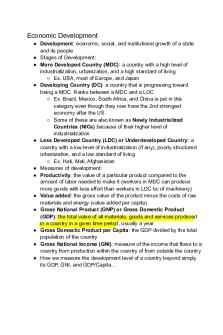Key Concepts in Human Geography II PDF

| Title | Key Concepts in Human Geography II |
|---|---|
| Author | Ana Marelja |
| Course | Human Geographies: City and Economy |
| Institution | McMaster University |
| Pages | 2 |
| File Size | 57.2 KB |
| File Type | |
| Total Downloads | 50 |
| Total Views | 122 |
Summary
Download Key Concepts in Human Geography II PDF
Description
Key Concepts in Human Geography II GEOG 1HB3 09/12/2019 FIRST LAW OF GEOGRAPHY: Everything is related to everything, but near things are more related than distant things – Waldo Tobler Geographic Literacy Previous key concepts were space, location/place, distance, distribution etc (similar to GEOG 1HA3) Key concepts today are diffusion, spatial interactions, distance decay, friction of distance, gravity models Diffusion Referred to as the process of geographic phenomena spreading over space and through time (anything on the world’s surface = a geographic phenomenon) o Depends on the distance separating points, density of the geographic phenomena, and the friction of distance (e.g how something will diffuse from one city to another depending on the distance between them) EXAMPLE: Walmart starts off in Arkansas and spreads business to the states surrounding Arkansas before they blew up as a company) Cultural Diffusion Referred to as the process of cultural phenomena (e.g ideas, innovations, trends, languages) spreading over space and through time (religion, language, musical styles, etc.) Forms of Diffusion Relocation diffusion is one of two basic forms of diffusion, in which the geographic phenomena are physically moved from one area to another, such as through immigration or trade (e.g immigrants’ cultural suitcase/bringing culture to a new place like language/culture) o Euros (currency) are a well-known aspect of relocation diffusion, each country has their own coin, but they are interchangeable (study was done to see if people of different countries within Europe possessed any euro coins that were not originated from their residing country) Expansion diffusion is when geographic phenomena is spread from area to another through additive process (known to be influenced by the number and proximity of contacts (e.g infection, disease, gossip and rumours, religion) Hierarchical Diffusion is one of two forms of expansion diffusion in which geographic phenomena spread first to key people or places and then gradually throughout the resr of a population or an area o Influenced by key and highly connected and influential people and places at the top of a hierarchy (new technology, fashion, music) Spatial Interaction Connecting concepts of location and distance is called spatial interaction
It is known to be the nature and extent of the relationship or linkages between locations; the extent of spatial interaction is related to the distances between locations and the physical and intangible connections between them Distance Decay and Friction of Distance Distance decay refers to the effects of distance on spatial interaction; generally, intensity of interaction diminishes with increasing distance (e.g a friend in high school is only your friend due to the fact that you see them every day) Friction of distance is a measure of the restraining effect of distance on human interaction and movement; generally greater time and cost are incurred with increasing distance (e.g obstacles due to distance such as costs/time will cause someone to refrain from putting in an effort towards interaction with an increased distance) Accessibility and connectivity are key components that influence the extent of spatial interaction (while reducing the friction of distance) o Accessibility is the variable quality of a location, expressing the opportunity for interaction with other locations o The relative ease with which a location can be reached (e.g air travel/trains) o Transportation and communication innovations, making locations more accessible (e.g creating more one-way flights instead of connecting flights for efficiency) o Connectivity is the direct and indirect linkages between two or more locations (e.g transportation/communications pathways) WITH tangible connections (ike highways and hydroelectric power lines) or intangible connections (homeland and local) Gravity Gravity models measure the quantity of movement (or interaction) between two places Regards relative sizes, distances, and distance decay function (the rate at which interaction declines with distance)/also related to accessibility and connectivity...
Similar Free PDFs

Human Geography Exam 2
- 38 Pages

Key Concepts in HRM A2
- 12 Pages

Key Concepts in HRM A3
- 14 Pages

Chapter 4 human geography
- 4 Pages

Human Geography Chapter 11 Notes
- 2 Pages

Human Geography Chapter 7 Notes
- 2 Pages

Human geography test 3 review
- 10 Pages

Human Geography Chapter 6 Notes
- 3 Pages
Popular Institutions
- Tinajero National High School - Annex
- Politeknik Caltex Riau
- Yokohama City University
- SGT University
- University of Al-Qadisiyah
- Divine Word College of Vigan
- Techniek College Rotterdam
- Universidade de Santiago
- Universiti Teknologi MARA Cawangan Johor Kampus Pasir Gudang
- Poltekkes Kemenkes Yogyakarta
- Baguio City National High School
- Colegio san marcos
- preparatoria uno
- Centro de Bachillerato Tecnológico Industrial y de Servicios No. 107
- Dalian Maritime University
- Quang Trung Secondary School
- Colegio Tecnológico en Informática
- Corporación Regional de Educación Superior
- Grupo CEDVA
- Dar Al Uloom University
- Centro de Estudios Preuniversitarios de la Universidad Nacional de Ingeniería
- 上智大学
- Aakash International School, Nuna Majara
- San Felipe Neri Catholic School
- Kang Chiao International School - New Taipei City
- Misamis Occidental National High School
- Institución Educativa Escuela Normal Juan Ladrilleros
- Kolehiyo ng Pantukan
- Batanes State College
- Instituto Continental
- Sekolah Menengah Kejuruan Kesehatan Kaltara (Tarakan)
- Colegio de La Inmaculada Concepcion - Cebu







